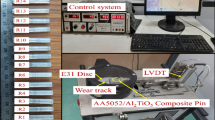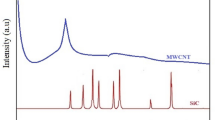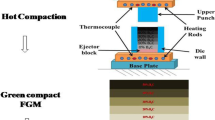Abstract
In the present study, an experimental investigation is conducted to determine the effect of process parameters on the depth of penetration and surface integrity in AZ91-metal matrix composite containing 1, 1.5, and 2 wt% of Al2O3 nano-particles through abrasive water jet cutting. Mixed level L18 orthogonal array is employed to conduct linear cutting experiments for both base alloy and nano-composites. Stir casting method is used to produce metal matrix nano-composites. The micro-mechanisms involved in material removal process are analyzed using SEM. Surface integrity of cut surfaces has been characterized using surface topography and 2D roughness profile observations. Water pressure and traverse speed are found to be the most significant factors in deciding depth of penetration. Penetration ability of nano-composites is decreased with increase in wt% of nano-Al2O3 particles. Two cutting regime, i.e., cutting wear and deformation wear, are observed from the SEM analysis and these mechanisms are found similar to the material removal mechanism in Mg alloys and other ductile materials. Contribution of high speed water jet to material removal process is also discussed. Embedment of sharp edged and spherical abrasive particles is observed in the micro-cutting and deformation regions. Surface quality produced by abrasive water jet in nano-composites found increased with increase in wt% of Al2O3 when compared to base alloy. Traverse speed, water pressure, and garnet size showed significant effect on surface quality produced by abrasive water jet. Micro-melting was observed in a few regions of the cut surfaces in nano-composites and melted region is affected by oxidation. Formation of short continuous ribbon type chips was also observed in some regions of cut surfaces, indicating the shear mechanism is also involved in the cutting process.

























Similar content being viewed by others
Abbreviations
- AWJ :
-
abrasive water jet
- AWJM:
-
abrasive water jet machining
- AWJC:
-
abrasive water jet cutting
- UAV:
-
unmanned aerial vehicle
- FBU:
-
flank build-up
- MMC:
-
metal matrix composites
- MMNC:
-
metal matrix nano-composites
- SEM:
-
scanning electron microscopy
- EDS:
-
energy dispersive spectroscopy
- XRD:
-
X-ray diffraction
- PCD:
-
polycrystalline diamond
- NTM:
-
non-traditional machining
- LBM:
-
laser beam machining
- LAM:
-
laser assisted machining
- EDM:
-
electrical discharge machining
- DOP:
-
depth of penetration
- Nz:
-
nozzle (focusing tube) diameter
- WP:
-
water pressure
- Ts:
-
traverse speed
- Mf:
-
mass flow rate
- CO2 :
-
carbon dioxide
- SF6 :
-
sulfur hexafluoride
- IDZ:
-
initial damage zone
- SCZ:
-
smooth cutting zone
- RCZ:
-
rough cutting zone
References
Diem, W. Magnesium in different applications. AutoTechnol 1, 40–41 (2001). https://doi.org/10.1007/BF03246578
Gupta M, Wong WLE (2015) “Magnesium-based nanocomposites: Lightweight materials of the future”. Mater Charact 105:30–46. https://doi.org/10.1016/J.MATCHAR.2015.04.015
Akyüz B (2014) Comparison of the machinability and wear properties of magnesium alloys. Int J Adv Manuf Technol 75:1735–1742. https://doi.org/10.1007/s00170-014-6256-y
Ponappa K, Aravindan S, Rao PV, Ramkumar J, Gupta M (2010) The effect of process parameters on machining of magnesium nano alumina composites through EDM. Int J Adv Manuf Technol 46:1035–1042. https://doi.org/10.1007/s00170-009-2158-9
Kempen K, Thijs L, Van Humbeeck J, Kruth J-P (2014) Processing AlSi10Mg by selective laser melting: parameter optimisation and material characterisation. Mater Sci Technol 31:917–923. https://doi.org/10.1179/1743284714y.0000000702
van Luttervelt CA (1989) On the selection of manufacturing methods illustrated by an overview of separation techniques for sheet materials. CIRP Ann 38:587–607. https://doi.org/10.1016/S0007-8506(07)61127-5
Paul S, Hoogstrate A, van Luttervelt C, Kals HJ (1998) Analytical and experimental modelling of the abrasive water jet cutting of ductile materials. J Mater Process Technol 73:189–199. https://doi.org/10.1016/S0924-0136(97)00228-8
Yuvaraj N, Pradeep Kumar M (2015) Multiresponse optimization of abrasive water jet cutting process parameters using TOPSIS approach. Mater Manuf Process 30:882–889. https://doi.org/10.1080/10426914.2014.994763
Ay M, Çaydaş U, Hasçalik A (2010) Effect of traverse speed on abrasive waterjet machining of age hardened inconel 718 nickel-based superalloy. Mater Manuf Process 25:1160–1165. https://doi.org/10.1080/10426914.2010.502953
Srinivas S, Babu NR (2012) Penetration ability of abrasive waterjets in cutting of aluminum-silicon carbide particulate metal matrix composites. Mach Sci Technol 16:337–354. https://doi.org/10.1080/10910344.2012.698935
Villeta M, De Agustina B, De Pipaón JMS, Rubio EM (2012) Efficient optimisation of machining processes based on technical specifications for surface roughness: application to magnesium pieces in the aerospace industry. Int J Adv Manuf Technol 60:1237–1246. https://doi.org/10.1007/s00170-011-3685-8
Mardi KB, Dixit AR, Mallick A, Pramanik A, Ballokova B, Hvizdos P, Foldyna J, Scucka J, Hlavacek P, Zelenak M (2017) Surface integrity of Mg-based nanocomposite produced by abrasive water jet machining (AWJM). Mater Manuf Process 32:1707–1714. https://doi.org/10.1080/10426914.2017.1279306
Ramulu M (1993) Dynamic photoelastic investigation on the mechanics of waterjet and abrasive waterjet machining. Opt Lasers Eng 19:43–65. https://doi.org/10.1016/0143-8166(93)90035-J
Babu MK, Chetty OVK (2006) A study on the use of single mesh size abrasives in abrasive waterjet machining. Int J Adv Manuf Technol 29:532–540. https://doi.org/10.1007/BF02729106
Jegaraj JJR, Babu NR (2005) A strategy for efficient and quality cutting of materials with abrasive waterjets considering the variation in orifice and focusing nozzle diameter. Int J Mach Tools Manuf 45:1443–1450. https://doi.org/10.1016/j.ijmachtools.2005.01.020
Kantha Babu M, Krishnaiah Chetty OV (2002) Studies on recharging of abrasives in abrasive water jet machining. Int J Adv Manuf Technol 19:697–703. https://doi.org/10.1007/s001700200115
Boud F, Carpenter C, Folkes J, Shipway PH (2010) Abrasive waterjet cutting of a titanium alloy: the influence of abrasive morphology and mechanical properties on workpiece grit embedment and cut quality. J Mater Process Technol 210:2197–2205. https://doi.org/10.1016/j.jmatprotec.2010.08.006
Yang WH, Tarng YS (1998) Design optimization of cutting parameters for turning operations based on the Taguchi method. J Mater Process Technol 84:122–129. https://doi.org/10.1016/S0924-0136(98)00079-X
ISO EN (1996) "4288—Geometrical product specifications (GPS)—surface texture: profile method–rules and procedures for the assessment of surface texture.". International Organization for Standardization, Geneva
Zeng KTJJ (1993) Parameter prediction and cost analysis in abrasive waterjet cutting operations. Ass., in: Hashish M Proc. 7th Amer. Water Jet Con, (1), Water Jet Techn., St. Louis, 1993: pp. 175–189
Karakurt I, Aydin G, Aydiner K (2012) An experimental study on the depth of cut of granite in abrasive waterjet cutting. Mater Manuf Process 27:538–544. https://doi.org/10.1080/10426914.2011.593231
Lemma E, Chen L, Siores E, Wang J (2002) Optimising the AWJ cutting process of ductile materials using nozzle oscillation technique. Int J Mach Tools Manuf 42:781–789. https://doi.org/10.1016/S0890-6955(02)00017-2
Zeng T, Kim J (1991) Material removal of polycrystalline ceramics by a high pressure abrasive water jet-a SEM study. Int J Water Jet Technol 1:65–71
Savrun E, Taya M (1988) Surface characterization of SiC whisker/2124 aluminium and Al2O3 composites machined by abrasive water jet. J Mater Sci 23:1453–1458. https://doi.org/10.1007/BF01154616
Kahlman L, Öjmertz KM, Falk LK (2001) Abrasive-waterjet testing of thermo-mechanical wear of ceramics. Wear. 248:16–28. https://doi.org/10.1016/S0043-1648(00)00457-9
Yuvaraj N, Kumar MP (2016) Cutting of aluminium alloy with abrasive water jet and cryogenic assisted abrasive water jet: a comparative study of the surface integrity approach. Wear. 362–363:18–32. https://doi.org/10.1016/j.wear.2016.05.008
Gudimetla P, Wang J, Wong W (2002) Kerf formation analysis in the abrasive waterjet cutting of industrial ceramics. J Mater Process Technol 128:123–129. https://doi.org/10.1016/S0924-0136(02)00437-5
Khodke PM, Tidke DJ, Ramarao AV (1996) An analytical model for material removal in abrasive jet machining for brittle materials. Mater Manuf Process 11:535–554. https://doi.org/10.1080/10426919608947507
Acknowledgments
The authors would like to express their sincere thanks to TEQIP, BMS College of Engineering, Bengaluru, for providing financial assistance to develop nano-composites and facilities to carry out experiments.
Author information
Authors and Affiliations
Corresponding author
Additional information
Publisher’s note
Springer Nature remains neutral with regard to jurisdictional claims in published maps and institutional affiliations.
Rights and permissions
About this article
Cite this article
Niranjan, C.A., Srinivas, S. & Ramachandra, M. Experimental investigations on depth of penetration and surface integrity in AZ91/Al2O3 nano-composites cut by abrasive water jet. Int J Adv Manuf Technol 107, 747–762 (2020). https://doi.org/10.1007/s00170-020-05069-4
Received:
Accepted:
Published:
Issue Date:
DOI: https://doi.org/10.1007/s00170-020-05069-4




